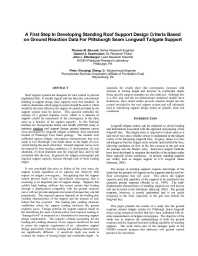Mining Publication: A First Step in Developing Roof Support Design Criteria Based on Ground Reaction Data for Pittsburgh Seam Longwall Tailgate Support
Original creation date: July 2008
Roof support systems are designed for roof control to prevent unplanned falls. It sounds logical and has been the conventional thinking in support design since supports were first installed. In order to determine which support system should be used or which would be the most effective, the degree of control provided by the support system must be known. This question embodies the concept of a ground response curve, which is a measure of support control by assessment of the convergence in the mine entry as a function of the support capacity. In this National Institute for Occupational Safety and Health (NIOSH) study to optimize standing roof support design, ground response curves were developed for longwall tailgate conditions from numerical models of Pittsburgh Coal Seam geology. The models were calibrated against tailgate convergence measurements that were made in two Pittsburgh Coal Seam mines as the depth of cover varied during the panel extraction. Ground response curves were developed for four loading conditions: (1) development, (2) side abutment, (3) front abutment near the longwall face, and (4) full extraction inby the face. In general, the tailgate convergence and required support capacity increase through each of these loading stages. It was concluded that prior to failure of the rock mass, the support system regardless of its capacity has relatively little impact on tailgate convergence. Recognizing that the support cannot prevent much of the (pre-failure) convergence that is occurring is an important part of support design. Supports that exhibit high loading stiffness but cannot sustain that loading through a displacement compatible with the ground response curve will not provide adequate roof control because they can fail prematurely. The required capacity depends on the loading plus yielding characteristics of the support and the amount of rock failure that has occurred. The loading plus yielding character establishes where the support loading intersects the ground response curve. Design criterion for support capacity based on the identifying the onset of strain-soften rock response leading to "damaged roof" is proposed as a foundation for assessing support design requirements. The capacity without accounting for the loading and yielding character of one support should not be used to assess the capacity requirement of an alternative support design, particularly when the loading and yielding characteristics are significantly different. A sensitivity study was made to evaluate the impact of mining height and overburden depth. As expected, the results show that convergence increases with increase in mining height and increase in overburden depth. Some specific support examples are also analyzed. Although this is a first step and the two-dimensional numerical models have limitations, these initial studies provide valuable insight into the control provided by the roof support system and will ultimately lead to optimizing support design based on specific mine site conditions.
Authors: TM Barczak, GS Esterhuizen, JL Ellenberger, P Zhang
Conference Paper - July 2008
NIOSHTIC2 Number: 20034272
Proceedings of the 27th International Conference on Ground Control in Mining, July 29 - July 31, 2008, Morgantown, West Virginia. Peng SS, Mark C, Finfinger GL, Tadolini SC, Khair AW, Heasley KA, Luo-Y, eds., Morgantown, WV: West Virginia University, 2008; :349-359
See Also
- Analysis of the Interaction Between Mobile Roof Supports and Mine Strata
- Case History of the Response of a Longwall Entry Subjected to Concentrated Horizontal Stress
- Coal Bumps and Odd Dynamic Phenomena - A Numerical Investigation
- Coal Mine Subsidence Prediction Using a Boundary-Element Program
- Development of Ground Response Curves for Longwall Tailgate Support Design
- Evaluation of the Impact of Standing Support on Ground Behavior in Longwall Tailgates
- Longwall Shield and Standing Gateroad Support Designs - Is Bigger Better?
- Numerical Modeling for Increased Understanding of the Behavior and Performance of Coal Mine Stoppings
- Pumpable Roof Supports: Developing Design Criteria by Measurement of the Ground Reaction Curve
- Updating the NIOSH Support Technology Optimization Program (STOP) With New Support Technologies and Additional Design Features
- Page last reviewed: 9/21/2012
- Page last updated: 9/21/2012
- Content source: National Institute for Occupational Safety and Health, Mining Program


 ShareCompartir
ShareCompartir
